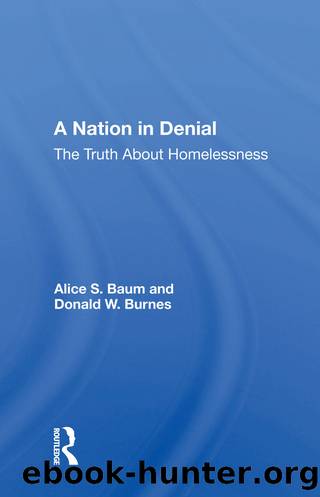A Nation In Denial by Alice S. Baum

Author:Alice S. Baum [Baum, Alice S.]
Language: eng
Format: epub
ISBN: 9780429722622
Barnesnoble:
Publisher: Taylor & Francis
Published: 2019-03-07T00:00:00+00:00
Who Are the Homeless? Just "Ordinary People"
Politics and political perspectives also surround the descriptions of who makes up the homeless population. Most common are the efforts by advocates to portray the homeless as people just like everyone else who happen to be suffering from the effects of stagflation, recession, and unemployment. Such descriptions discount the disabling conditions found among the majority of the homeless. A congressional report stated:
Typically, we think of the homeless as drunks, drug addicts, or mentally disturbed people and, at one time, a majority of the homeless may have fit these categories. But, as the witnesses today will make clear, many homeless people are perfectly normal. They are like us, except that we have the good fortune to have a place in which to live.62
In this short statement, Congressman Charles E. Schumer, a Democrat from New York, confirmed the effectiveness of the political crusade to portray today's homeless as people just like anyone else; those who do have homes, according to this portrayal, are just a paycheck or a streak of bad luck away from homelessness. The homeless are ordinary members of our community: "The older woman next to you on the bus may be going nowhere in particular, riding only to keep warm or dry or seated. . . . [T]he well-dressed man nursing a cup of coffee at the lunch counter is not necessarily an executive mulling over a tough business decision, nor is the family at the local campground necessarily on vacation."63
The homeless "are just like the rest of us. . . . [They] want the same things you doâsometimes they want to talk, sometimes they'd rather be private."64 Susan Baker, chairman of the National Alliance to End Homelessness, said that the homeless "miss the comfort of conversation, books, music, and peaceful reflection that we take for granted. It's the simple things in lifeâ having conversations with friends, being complimented when you've done something well, hearing music or seeing beautiful thingsâthat can give you the reinforcement you need. We shouldn't neglect this side of life when we think about what we can do to help homeless people."65 The message is that the homeless or the prehomeless or the potential homeless are just like members of the general public and, therefore, helping them is like helping our neighbors.
Another approach is to portray the homeless family as the two-parent, rust belt family sleeping in cars, temporarily out of work, suddenly unable to afford housing in a market of skyrocketing housing prices and declining government subsidies to help the poor. This is despite almost universal findings that the vast majority of homeless families consist of single adult women accompanied by children.66 A fine example of this error appears in Jonathan Kozol's book about homeless families in New York City, Rachel and Her Children. To be sure that readers understand that homeless families are just like other families, Kozol's first chapter is entitled "Ordinary People." The family that Kozol described is a two-parent family: "He was a carpenter. She was a woman many people nowadays would call old-fashioned.
Download
This site does not store any files on its server. We only index and link to content provided by other sites. Please contact the content providers to delete copyright contents if any and email us, we'll remove relevant links or contents immediately.
Cecilia; Or, Memoirs of an Heiress — Volume 1 by Fanny Burney(32053)
Cecilia; Or, Memoirs of an Heiress — Volume 3 by Fanny Burney(31449)
Cecilia; Or, Memoirs of an Heiress — Volume 2 by Fanny Burney(31401)
The Great Music City by Andrea Baker(30778)
We're Going to Need More Wine by Gabrielle Union(18625)
All the Missing Girls by Megan Miranda(14699)
Pimp by Iceberg Slim(13769)
Bombshells: Glamour Girls of a Lifetime by Sullivan Steve(13680)
Fifty Shades Freed by E L James(12907)
Talking to Strangers by Malcolm Gladwell(12860)
Norse Mythology by Gaiman Neil(12818)
For the Love of Europe by Rick Steves(11427)
Crazy Rich Asians by Kevin Kwan(8883)
Mindhunter: Inside the FBI's Elite Serial Crime Unit by John E. Douglas & Mark Olshaker(8695)
The Lost Art of Listening by Michael P. Nichols(7154)
Enlightenment Now: The Case for Reason, Science, Humanism, and Progress by Steven Pinker(6868)
The Four Agreements by Don Miguel Ruiz(6310)
Bad Blood by John Carreyrou(6271)
Weapons of Math Destruction by Cathy O'Neil(5823)
